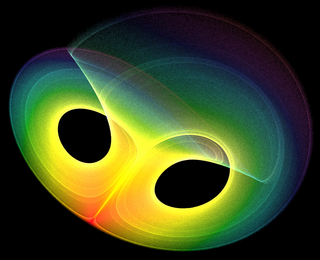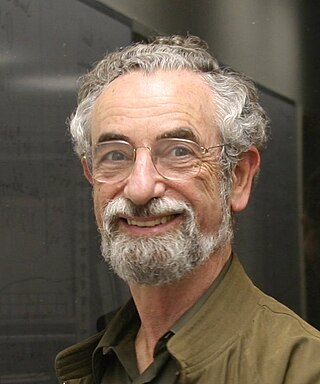Related Research Articles

Theoretical chemistry is the branch of chemistry which develops theoretical generalizations that are part of the theoretical arsenal of modern chemistry: for example, the concepts of chemical bonding, chemical reaction, valence, the surface of potential energy, molecular orbitals, orbital interactions, and molecule activation.

Analysis is the branch of mathematics dealing with continuous functions, limits, and related theories, such as differentiation, integration, measure, infinite sequences, series, and analytic functions.

Mathematical physics refers to the development of mathematical methods for application to problems in physics. The Journal of Mathematical Physics defines the field as "the application of mathematics to problems in physics and the development of mathematical methods suitable for such applications and for the formulation of physical theories". An alternative definition would also include those mathematics that are inspired by physics, known as physical mathematics.
In mathematics, a unitary representation of a group G is a linear representation π of G on a complex Hilbert space V such that π(g) is a unitary operator for every g ∈ G. The general theory is well-developed in the case that G is a locally compact (Hausdorff) topological group and the representations are strongly continuous.
In science and especially in mathematical studies, a variational principle is one that enables a problem to be solved using calculus of variations, which concerns finding functions that optimize the values of quantities that depend on those functions. For example, the problem of determining the shape of a hanging chain suspended at both ends—a catenary—can be solved using variational calculus, and in this case, the variational principle is the following: The solution is a function that minimizes the gravitational potential energy of the chain.
In functional analysis, a branch of mathematics, the Hellinger–Toeplitz theorem states that an everywhere-defined symmetric operator on a Hilbert space with inner product is bounded. By definition, an operator A is symmetric if

Marshall Harvey Stone was an American mathematician who contributed to real analysis, functional analysis, topology and the study of Boolean algebras.
While working on the mathematical physics of an interacting, relativistic, quantum field theory, Rudolf Haag developed an argument against the existence of the interaction picture, a result now commonly known as Haag’s theorem. Haag’s original proof relied on the specific form of then-common field theories, but subsequently generalized by a number of authors, notably Hall & Wightman, who concluded that no single, universal Hilbert space representation can describe both free and interacting fields. A generalization due to Reed & Simon shows that applies to free neutral scalar fields of different masses, which implies that the interaction picture is always inconsistent, even in the case of a free field.
The spectrum of a linear operator that operates on a Banach space is a fundamental concept of functional analysis. The spectrum consists of all scalars such that the operator does not have a bounded inverse on . The spectrum has a standard decomposition into three parts:
In mathematics, particularly in functional analysis, a projection-valued measure is a function defined on certain subsets of a fixed set and whose values are self-adjoint projections on a fixed Hilbert space. A projection-valued measure (PVM) is formally similar to a real-valued measure, except that its values are self-adjoint projections rather than real numbers. As in the case of ordinary measures, it is possible to integrate complex-valued functions with respect to a PVM; the result of such an integration is a linear operator on the given Hilbert space.
In mathematics, more specifically functional analysis and operator theory, the notion of unbounded operator provides an abstract framework for dealing with differential operators, unbounded observables in quantum mechanics, and other cases.

Elliott Hershel Lieb is an American mathematical physicist. He is a professor of mathematics and physics at Princeton University. Lieb's works pertain to quantum and classical many-body problem, atomic structure, the stability of matter, functional inequalities, the theory of magnetism, and the Hubbard model.

Barry Martin Simon is an American mathematical physicist and was the IBM professor of Mathematics and Theoretical Physics at Caltech, known for his prolific contributions in spectral theory, functional analysis, and nonrelativistic quantum mechanics, including the connections to atomic and molecular physics. He has authored more than 400 publications on mathematics and physics.

Alexander Leonidovich Kuzemsky is a Russian theoretical physicist.

In mathematics, Hilbert spaces allow the methods of linear algebra and calculus to be generalized from (finite-dimensional) Euclidean vector spaces to spaces that may be infinite-dimensional. Hilbert spaces arise naturally and frequently in mathematics and physics, typically as function spaces. Formally, a Hilbert space is a vector space equipped with an inner product that induces a distance function for which the space is a complete metric space.
Harro Heuser was a German mathematician. In German-speaking countries he is best known for his popular two-volume introduction into real analysis, Lehrbuch der Analysis.
In mathematics, the Weyl–von Neumann theorem is a result in operator theory due to Hermann Weyl and John von Neumann. It states that, after the addition of a compact operator or Hilbert–Schmidt operator of arbitrarily small norm, a bounded self-adjoint operator or unitary operator on a Hilbert space is conjugate by a unitary operator to a diagonal operator. The results are subsumed in later generalizations for bounded normal operators due to David Berg and Dan-Virgil Voiculescu. The theorem and its generalizations were one of the starting points of operator K-homology, developed first by Lawrence G. Brown, Ronald Douglas and Peter Fillmore and, in greater generality, by Gennadi Kasparov.
Robert C. Hermann was an American mathematician and mathematical physicist. In the 1960s Hermann worked on elementary particle physics and quantum field theory, and published books which revealed the interconnections between vector bundles on Riemannian manifolds and gauge theory in physics, before these interconnections became "common knowledge" among physicists in the 1970s.
Charles Laurie Dolph was an American mathematician known for his research in applied mathematics and engineering.
References
- 1 2 3 Faris, William (1980). "Review of Methods of modern mathematical physics, vol. III, Scattering theory by M. Reed and B. Simon; Methods of modern mathematical physics, vol. IV, Analysis of operators by M. Reed and B. Simon". Bulletin of the American Mathematical Society . New Series. 2 (3): 522–530. doi: 10.1090/S0273-0979-1980-14789-8 . MR 1567254.
- ↑ M.C. Reed (2004) Why is Mathematical Biology so Hard?
- ↑ "Applications of Analysis to Mathematical Biology" (PDF). Duke University.
- ↑ List of Fellows of the American Mathematical Society, retrieved 2013-06-09.
- ↑ Feigenbaum, Mitchell J. "A Review of: Methods of Modern Mathematical Physics by Michael Reed and Barry Simon". Transport Theory and Statistical Physics. 2 (4): 373–375. doi:10.1080/00411457208232549.
- 1 2 Berberian, Sterling K. (1976). "Review of Funktionalanalysis by Harro Heuser; Geometric functional analysis and its applications by Richard B. Holmes; Functional analysis by M. Reed and B. Simon; Fourier analysis, self-adjointness by M. Reed and B. Simon". Bull. Amer. Math. Soc. 82 (6): 865–868. doi: 10.1090/S0002-9904-1976-14184-5 . MR 1566915.